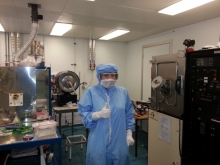
University:
Major:
Site Abroad:
Mentor(s):
Faculty Sponsor(s):
Faculty Sponsor's Department:
Project Title:
Project Description:
Silicon photovoltaics is a key technology to provide the world with renewable, inexpensive, and reliable energy. Efficiency in silicon solar cells is partly limited by recombination of photo-excited electron-hole pairs at surfaces and interfaces. A process to reduce this recombination is called surface passivation and the development of efficient new processes, that are also stable over time, is critical to the development of next generation solar cells. The goal of this project was to stabilize the passivation effect by modifying the surface dielectric films on silicon cells in a controlled manner. This was done using a point-to-plane corona discharge apparatus, which ionizes the air surrounding a high point potential and deposits charge uniformly onto the surface of the silicon dioxide films. The charge decay was then characterized using Kelvin Probe and capacitance-voltage devices, which measure the charge density at the surface and silicon- silicon dioxide interface respectively. When these two measurements are used in parallel, one can determine where the charge is located within the dielectric. By using short, high-temperature anneals, charge was gradually moved into the dielectric and the dynamics of motion were studied. In this way, a physical model of the deposited charge and its motion through the dielectric film was obtained. With this understanding, it is possible to move charge directly into the middle of the dielectric, where it will have the lowest probability of recombining with opposite charges at the surface and interface, thus making the solar cell more effective.
